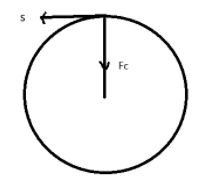
The work done by a centripetal force in a circular motion:
A. increases by decreasing the radius of circle
B.decreases by increasing the radius of circle
C.increases by increasing the mass of the body
D.is always zero
Answer
557.7k+ views
Hint: Work done by a body is the dot product of force and displacement in the direction of force. It is zero if the force vector and displacement vector are perpendicular.
Centripetal force is responsible for circular motion performed by a body and it always acts towards the Centre.
Complete answer:
When a body is performing a circular motion a force acts on it which is responsible for its motion which is centripetal force .It is always acting towards the radius of the circular path in which the body is moving.
Work done by centripetal force =centripetal force$\overset{\to }{\mathop{\left( {{F}_{C}} \right)}}\,$ $\times $ displacement of the body $\left( \overset{\to }{\mathop{s}}\, \right)$
Work done by a force is non zero only when the force vector and displacement vector are not perpendicular which means angle between them should not be ${{90}^{o}}$.

But as seen in the figure the displacement vector is perpendicular to the force vector which means work done by centripetal force on the body is zero throughout the motion of the body irrespective of whether we increase the mass of the body or radius of the body, or if we decrease the radius of the body.
So, the correct option of this question is D.
Note:
Centripetal force does not exist on its own but it is the net force acting on the body which provides necessary centripetal force to move on the circular path when many forces are acting on the body.
There are two types of circular motion
1.uniform circular motion
2.non-uniform circular motion.
Centrifugal force is equal in magnitude to the centripetal force but it acts away from the Centre of the circle
Centripetal force is responsible for circular motion performed by a body and it always acts towards the Centre.
Complete answer:
When a body is performing a circular motion a force acts on it which is responsible for its motion which is centripetal force .It is always acting towards the radius of the circular path in which the body is moving.
Work done by centripetal force =centripetal force$\overset{\to }{\mathop{\left( {{F}_{C}} \right)}}\,$ $\times $ displacement of the body $\left( \overset{\to }{\mathop{s}}\, \right)$
Work done by a force is non zero only when the force vector and displacement vector are not perpendicular which means angle between them should not be ${{90}^{o}}$.

But as seen in the figure the displacement vector is perpendicular to the force vector which means work done by centripetal force on the body is zero throughout the motion of the body irrespective of whether we increase the mass of the body or radius of the body, or if we decrease the radius of the body.
So, the correct option of this question is D.
Note:
Centripetal force does not exist on its own but it is the net force acting on the body which provides necessary centripetal force to move on the circular path when many forces are acting on the body.
There are two types of circular motion
1.uniform circular motion
2.non-uniform circular motion.
Centrifugal force is equal in magnitude to the centripetal force but it acts away from the Centre of the circle
Recently Updated Pages
Master Class 11 Economics: Engaging Questions & Answers for Success

Master Class 11 English: Engaging Questions & Answers for Success

Master Class 11 Social Science: Engaging Questions & Answers for Success

Master Class 11 Biology: Engaging Questions & Answers for Success

Class 11 Question and Answer - Your Ultimate Solutions Guide

Master Class 11 Business Studies: Engaging Questions & Answers for Success

Trending doubts
What is meant by exothermic and endothermic reactions class 11 chemistry CBSE

10 examples of friction in our daily life

One Metric ton is equal to kg A 10000 B 1000 C 100 class 11 physics CBSE

Difference Between Prokaryotic Cells and Eukaryotic Cells

What are Quantum numbers Explain the quantum number class 11 chemistry CBSE

1 Quintal is equal to a 110 kg b 10 kg c 100kg d 1000 class 11 physics CBSE




